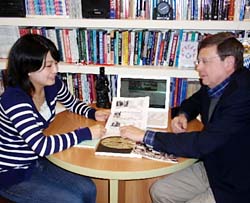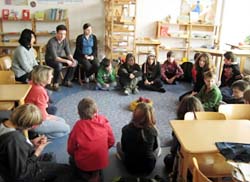Peace Seeds in the WorldAppeal for peace resonates overseas
|
The first issue of Peace Seeds was published on January 29, 2007. This fall, Peace Seeds will mark its 100th issue. The articles in Peace Seeds can also be read on our website, in both Japanese and English. Peace Seeds covers a wide range of peace-related issues beyond the atomic bombing of Hiroshima, including such concerns as conflict, bullying, the environment, and food. How are the thoughts of junior high school and high school students in the A-bombed city of Hiroshima being received by others out in the world? We found that schools in the United States and Germany are using Peace Seeds as material for their peace education activities. And there are Peace Seeds readers in Argentina, on the opposite side of the world. Through our work on this issue, the junior writers have again recognized the importance of conveying peace from Hiroshima. From this point forward, too, we will continue to express the preciousness of peace and life, an ideal beyond all national borders, through Peace Seeds. |
 University of Mount Union in Ohio
University of Mount Union in Ohio Kyoko Niiyama (left) discusses the peace studies course with Professor Coleman as the two look at Peace Seeds articles. (Photo courtesy of Kyoko Niiyama) |
At the University of Mount Union in the U.S. state of Ohio, Peace Seeds will be used in a peace studies course that starts this August. William Coleman, 65, a professor of communications, will be teaching the class. He pointed out that the average American college student has no detailed knowledge of the atomic bombings. In the course, he hopes to provide students with the opportunity and inspiration to ponder peace issues.
Professor Coleman plans to ask his students to read Peace Seeds articles on the website in English and respond by writing their impressions. The students will also engage in discussion with junior writers in Hiroshima through email or Skype, an Internet telephone service.
Kyoko Niiyama, 21, a former junior writer, was the person who introduced Professor Coleman to Peace Seeds. Kyoko will be a senior at the school starting in August. "I hope the students will see a link between Hiroshima and peace, not only Hiroshima and the atomic bomb," Kyoko said. (Chisa Nishida, 16, and Megumi Iwata, 17)
 Stuyvesant High School in New York
Stuyvesant High School in New York Students take a quiz on Hiroshima and the atomic bombing at Stuyvesant High School in New York. (Photo courtesy of Chie Helinski) |
At Stuyvesant High School in the U.S. state of New York, a Japanese teacher, Chie Helinski, 50, a native of Tokyo, uses the "Hiroshima Quiz," which appeared in Peace Seeds in the summer of 2008, in her third-year Japanese course.
As knowledge about the atomic bombing is needed to answer the quiz, Ms. Helinski began using it in the winter of 2008 as a way for her students to learn about the atomic bombing. She prints out the quiz page from the website, in Japanese, and distributes it to the students. They then try to answer the 20 questions, which include such questions as "Why has the A-bomb Dome been preserved?" and "Which country DOES NOT currently possess nuclear weapons?" The highest score last winter was 70 points out of 100. The average score, however, was 50 points. Ms. Helinski told us: "If they fail to choose the correct answer, it gives them motivation to learn more about it."
Her class now includes students from India and Pakistan, both nations which hold nuclear weapons. "It's important to reflect on nuclear issues and peace issues together while learning about Hiroshima's experience," she said, adding that she sees results in their focus on Hiroshima. "My students have begun to widen their outlook and empathize with other people's pain." (Arata Kohno, 13)
 Montessori Junior High School in Nuremberg, Germany
Montessori Junior High School in Nuremberg, Germany Students of Montessori Schule (Montessori Junior High School) in Nuremberg, Germany, used Peace Seeds to study about peace. (Photographed in February 2009; photo courtesy of Atsuko Kato) |
At an elementary school and junior high school in the city of Nuremberg in southern Germany, Peace Seeds was used in 2009 and 2010. From our English website, students were able to learn the basic facts of the atomic bombing of Hiroshima.
In a project to promote international understanding coordinated by the Nuremberg city government, an elementary school and a junior high school learned about the atomic bombings of Hiroshima and Nagasaki. One of these schools, Montessori Schule (Montessori Junior High School), made good use of Peace Seeds, listened to the account of an A-bomb survivor who lives in Berlin, and exchanged email messages with a junior high school in Hiroshima.
A sculptor who lives in the nearby city of F?rth, Kunihiko Kato, 65, and his wife Atsuko, 60, who is a painter, told the school about Peace Seeds. The couple organizes a ceremony for Hiroshima and Nagasaki at the school every August 6. Atsuko explained that they introduced the school to Peace Seeds because "The young people in Hiroshima write fine articles and I thought the German children would be able to understand them easily."
Kiki Schmidt, 45, an official of the Nuremberg city government, was in charge of the project. She told us: "This effort by Japanese students of the same age offers good motivation to German students. I'd like to introduce Peace Seeds to other schools so it can be used for peace education activities." (Junichi Akiyama, 15, and Mako Sakamoto, 14)
 NGO representative in Argentina, Tomoko Aikawa
NGO representative in Argentina, Tomoko Aikawa 
Tomoko Aikawa, 44, is a native of Hiroshima and the head of the NGO "Fundaci?n Sadako," which promotes peace with paper cranes. She wrote an article in Spanish about the efforts of the junior writers for the local newspaper "Peri?dico La Plata Hochi."縲
The article appeared in the newspaper on August 6, 2009 with the headline "Grandes iniciativas de los m?s peque?os" ("Big Effort by Small People"). The article included information on a Peace Seeds project to invite U.S. President Barack Obama to Hiroshima as well as an interview with the film director Hayao Miyazaki.
Ms. Aikawa came to learn about Peace Seeds via the Internet. She said, "I want to convey the idea expressed by Peace Seeds that reconciliation is more important than carrying a grudge and peace can be created if we live peaceful lives in harmony with others."
In the future, she plans to introduce people in Argentina to the game "Peace Karuta," based on a traditional Japanese card game, which was developed by the junior writers of Peace Seeds. (Sayaka Azechi, 16, Yuka Iguchi, 16, and Arata Kohno, 13)